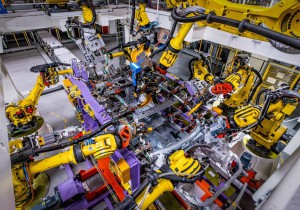Despite the softness in the Chinese economy, General Motors announced plans to introduce 60 new products in the China during the next five years, GM executives said this week.
During a visit to Beijing, GM President Dan Ammann announced the GM strategic plan for the next five years to fuel its growth momentum in China, where it now is the second-largest carmaker just behind Volkswagen.
The strategy will provide an even stronger product mix, greener technologies and smarter solutions for personal mobility in the world’s largest vehicle market, according to Ammann.
Between now and 2020, GM and its joint ventures plan to roll out more than 60 new and refreshed models in China, including 13 this year, with a strong focus on SUVs, MPVs and luxury vehicles, Ammann said, noting that the strong demand by customers generated record vehicle deliveries, which helped China remain GM’s largest market.
Last year, China accounted for more than one-third of GM’s total deliveries worldwide. GM expects China’s vehicle market to increase by 5 million units or more by 2020, representing growth of about 3-5% annually, GM executives said.
“GM is very well positioned to participate in this growth,” said GM Executive Vice President and GM China President Matt Tsien today. “We will continue to focus on the segments where the demand is strong and growing. This has been a key to our success from day one.”
GM anticipates about 4.2 million units of growth in China’s SUV, MPV and luxury segments through 2020, with the industry’s luxury segment expected to generate compound annual growth of more than 10% during that period, Tsien added.
To capitalize on this trend, about 40% of the new vehicles that GM launches in China over the next five years will be SUVs and MPVs, and GM’s Cadillac luxury brand will introduce 10 new and refreshed models.
(Ford sales slide 8.7% in February. For more, Click Here.)
During the same period, GM and its joint ventures will roll out more than 10 new energy vehicles under the Chevrolet, Buick, Cadillac and Baojun brands. They will include the Shanghai-built Cadillac CT6 Plug-in Hybrid Electric Vehicle, which will go on sale later this year.
The China market will also benefit from GM’s global initiatives to accelerate the refreshing of its portfolio. This year and in each of the next few years, 40% of the company’s global sales are expected to come from new and refreshed models, up significantly from 25% in 2015. Several of these vehicles will be developed, built and sold in China.
“Our core business of selling great vehicles today is what will fund our investment in tomorrow,” said Ammann. “The China market is maturing and it will still be a tremendous source of growth for us in both the short term and the long term,” he said.
The Chinese economy expanded by roughly 5% to 7% in 2015 but the numbers meant the rate of growth in China dropped from double digits for the first time in nearly two decades, rattling global markets and depressing the prices for commodities off all types oil to iron ore.
The worries over the direction of China’s economy is exacerbated by the need for restructuring in many sectors and the increase of bad or underperforming loans, which are putting pressure on the country’s financial system.
Nevertheless, GM plans to work with its Chinese partner SAIC, China’s largest automotive company, to replace several current vehicles for growth markets based on multiple architectures with an even larger family of vehicles based on one core architecture, Ammann said.
(Click Here for details about Cadillac shifting its focus to China and beyond.)
In addition to vehicles, GM is also addressing business opportunities in value-added services such as automotive financing and insurance.
Its SAIC-GMAC joint venture is the largest dedicated automotive finance company in China. By the end of this decade, GM sees potential for up to 40% of car buyers in China to finance their purchases, compared to about 30% in 2015.
The INSAIC joint venture will continue making it easier for customers to obtain insurance when purchasing GM vehicles. It will further channel vehicles to GM dealerships for repairs, providing customers additional peace of mind.
Ammann said GM is moving to capitalize on the future of personal mobility in China and elsewhere using tools such as connectivity, ridesharing, car sharing and autonomous driving.
GM holds nearly 500 connectivity patents and has been the industry leader for two decades with OnStar. By the end of 2016, GM will have 12 million OnStar-connected vehicles on the road. And by 2020, more than 75% of its global sales volume is expected to be actively connected. In China, all Cadillac, Buick and Chevrolet models will be connected by 2020.
Earlier this month, Shanghai OnStar and the Midea Group announced a unique strategic partnership for the integration of onboard telematics and smart household technology to enhance the consumer experience.
(To what caused GM China’s sales to drop 9.7% in February, Click Here.)
In January of this year, GM started its own personal mobility brand called Maven, which combines and expands the company’s multiple car-sharing programs, including the EN-V 2.0 pilot program with Shanghai Jiao Tong University.

